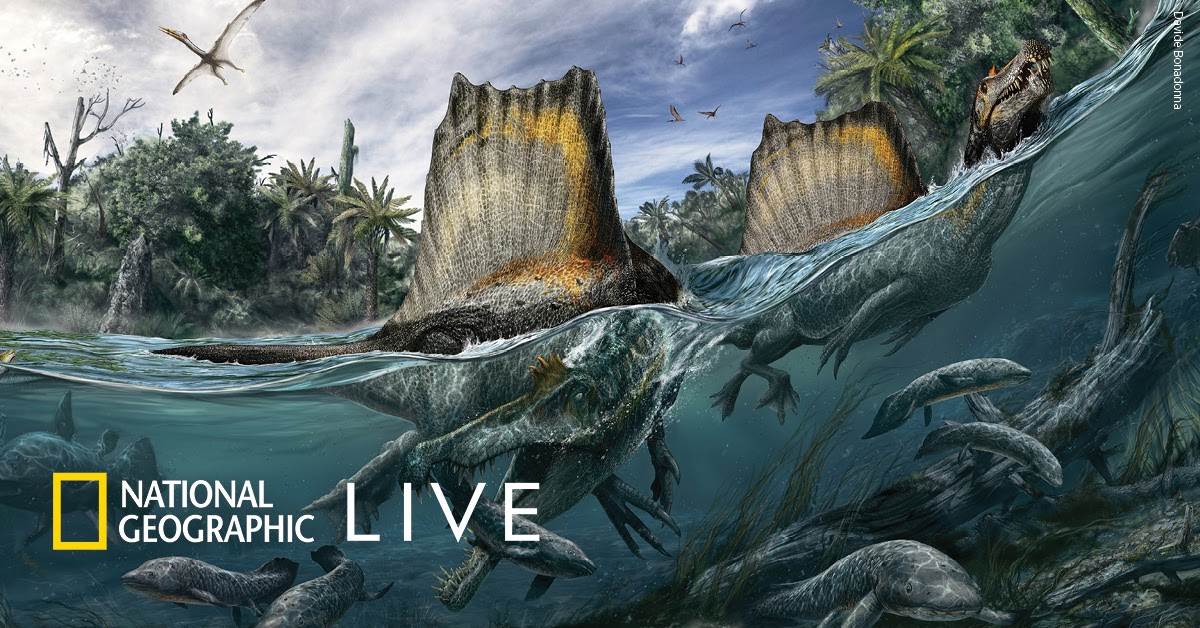Did you know that paleontologists have learned more about dinosaurs in the past 5 years than they did in the previous 250? That’s why National Geographic magazine dedicated its October 2020 issue to “Reimagining Dinosaurs” and National Geographic Live extended the excitement with two virtual events. If you want to catch the second event, click here to learn more about the presentation on Wednesday, February 24th, at 10 pm ET/7 pm PT. What follows is a recap of the first event, held on February 23rd.
Senior Director Andrew Pudvah was joined by National Geographic Explorers Nizar Ibrahim and Sebastián Rozadilla, along with a special surprise guest towards the end of the show. As with past events, both guests gave a presentation and had a mini Q&A session before joining together at the end for a bigger conversation about dinosaurs.
Nizar Ibrahim was recently featured on an episode of the Overheard at National Geographic podcast where he talked about recent discoveries of Spinosaurus (click here for a recap of that episode). With more paleontologists than ever before and new technological advancements helping scientists study fossils, he shared that we’re living in the golden age of paleontology. However, much of the previous research was biased, primarily focusing on fossils from western regions. Until recently, Africa was underrepresented in the worldwide story of dinosaurs.
The Spinosaurus was discovered over a century ago in the Sahara Desert by a German paleontologist, who didn’t have a complete skeleton and also took the bones with him back to Germany, where they ended up being destroyed in bombings during World War II. Even though other experts in the field told him it would be a fool's errand, Nizar was committed to digging in the famous desert in hopes of not only finding another Spinosaurus (just the one had ever been unearthed), but finding more of it. Not only did he find more Spinosaurus fossils, but his findings also redefined the region during the prehistoric period.
What’s now the Sahara Desert was once a lush space with fruitful river systems that paved the way for a “River of giants,” containing some of the largest dinosaurs ever discovered. The river housed fish the size of cars who were preyed upon by both the legendary Spinosaurus, but also giant Terrasaurus, with Nizar teasing that he has some new discoveries that will be revealed to the world soon.
Many scientists believed that dinosaurs didn’t go in the water, but everything Nizar discovered about Spinosaurus challenged that. It was longer than a T-Rex at 50-feet in length, had dense bones like water mammals, a slender jaw ideal for catching slippery prey, and a wide tail that could act like a propeller. It’s toes had claws, but were also set at weird angles and may have been webbed. Everything we now know about it suggests that Spinosaurus was specialized to hunt in the water and while it would have followed its prey onto land, it wouldn’t have been very agile out of the water. And we know all of this thanks to Nizar Ibrahim’s determination and unwillingness to take no for an answer. In fact, he’s found many more dinosaurs in the Sahara Desert since starting his work there.
Sebastián Rozadilla’s presentation was about what it’s like to hunt for dinosaur bones and how it can actually be done by anyone. Living in South America, a boy named Diego happened upon the remains of a small dinosaur, which he brought to the attention of local paleontologists. It ended up getting named after him and the country it was found in, the Chilesaurus Diegosuarezi.
For Sebastián, getting to his dig sites requires creativity, often having to climb to higher altitudes on horseback. He talked about how sometimes fossils are found in soft rock where they can be brushed out, while other times they’re in hard rock. That process requires making a plaster jacket to protect the bones, breaking rocks and hauling away heavy chunks to labs where the fossils can be revealed and studied. Sebastián is also an artist and shared some of the artwork he’s made of his findings.
The surprise special guest was Dr. Bolertsetseg Minji, who was also featured in an episode of Overheard at National Geographic titled “The United States vs. One Tyrannosaurus Bataar” (click here for our recap). In addition to starting a conversation about the risks of scientists losing fossils to private collectors and the fossil equivalent of poaching, she also talked about the work she’s doing in her home of Mongolia to help educate the public about their own dinosaurs. One of the most famous dinosaurs, Velociraptor, was discovered there. She takes a bus full of fossils around the country to teach kids about the dinosaurs native to Mongolia and to inspire them to be the next generation of local paleontologists.
The Show & Tell portion of the show included a fossil that each explorer found and the backstory behind each one. In the end, the message was clear. We’ve come a long way in our research and understanding of dinosaurs, but there’s a whole world of fossils out there waiting to be discovered to help complete the picture.
Click here to visit the official website of Nat Geo Live to learn more about upcoming events.

